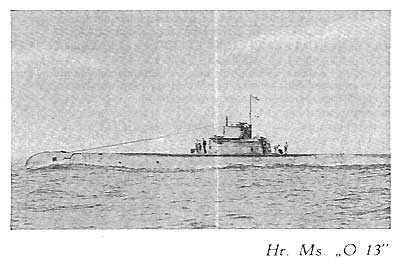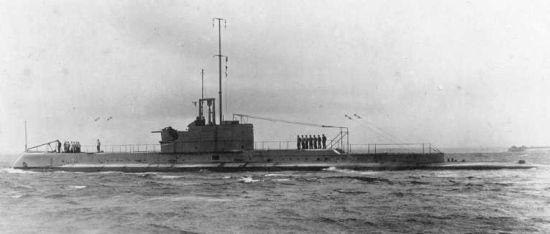The loss of the Dutch submarine Hr.Ms. O13 in June 1940.
Even a formal letter dated April 1946 from the Dutch Admiralty received by relatives of the O13 crew speaks about an attack by German Navel forces somewhere in the neighbourhood where the O13 was on patrol. Later investigation pointed out that this attack most probably concerned the english submarine the "Porpoise".
The question now is, is there any knowledge somewhere about what happened with submarine O13 and her crew in 1940 and about the position all this should have occured?
Since some years one can read notes concerning the War Cabinet meetings. Some fascinating notes concerning the O13 and other submarines have been posted here .....
The following more or less formel information about the loss of the Hr.Ms. O13 can be found on the internet:
- According the Royal Navy Historical Branch the Dutch submarine O13 was lost in a British minefield, on 13 June 1940, around 5700N 0340E, in the same field that claimed the Polish ORP Orzel. This information is recorded in the Public Records Office under Class Mark ADM 199/1925.
- The Dutch authorities however say that the O13 was lost in a German minefield 16B at about 5655N 03E. This German minefield was at that time unknown to the Allies.
- On the site "Seekrieg 1940, Mai" one can read:
9./10.5.1940
Nordsee
Die dt. Minenleger Roland, Cobra, Preußen und Kaiser laufen, gesichert von den Zerstörern Richard Beitzen, Hermann Schoemann, Bruno Heinemann und Torpedoboot Greif, zum Auswerfen der Minensperre 16 westl. der Great Fisherman’s Bank. .. but, the british fleet approaches .... Rechtzeitig meldet die 1. S-Flottille den Gegner und der Minenverband kann abdrehen ....
- Then on "Seekrieg 1940, Mai" it says:
17.5-20.5.1940
Nordsee
Minenunternehmungen mit Kreuzer Köln, Aviso Grille sowie den Zerstörern Bruno Heinemann, Hermann Schoemann und Richard Beitzen, die in den Nächten vom 17./18.5. und 19./20.5. in 2 Teilabschnitte die Minensperre 16 als Verlängerung der Westwall-Sperre werfen. Auf Sperre 16A (Position 56.45n 03.26e) sinkt wahrscheinlich Anfang August 1940 das britische U-Boot Thames
- On the site "WW II Day by Day" on the page "25.Mai 1940" the German mine fields 16A en 16B are mentioned, as follows:
North-sea
Gruppe West reports location of Barrier 16A and 16B:
16A: from 56°37’N 3°33’O to 56°51’N 3°24,5’O
16B: from 56°54’N 3°42’O to 57°08’N 3°36’O
The barrier is set at 3m under M.Spr.N.W.,
Explosive-buoies 6 – 8m under M.Spr.N.W.
- A mister Marek Twardowski on a Polish forum claims the following:
H.T.Lenton in "Navies of the Second World War - Royal Netherlands Navy" stated that on 13.06.1940 RNN O-13 was lost on mines in the North Sea. That version was given also in "Warships Supplement" 82 (p.9) and the position given is 57°N/3°40E. I understand this was an official version and both the date and position are only approximations. In "Warships Supplement" 84 Mr L.L. von Munching published corrections to the above, stating that O-13 was rammed by WILK on 20.06 in position 56°50N/3°57E. That rumour emerged already in June 1940, but was disregarded by official historians. Nevertheless it is repeated until today.
- On "Seekrieg 1940, Mai" the Polish ORP Orzel is also mentioned:
27.5.-14.6.1940
Norwegen
Auf einer weiteren Minensperre vor Südwestnorwegen geht am 25.5. (brit. Minensperre 57°00N 03°40E) oder am 8.6. (dt. Minensperre 16 B) das poln. U-Boot Orzel verloren.
As far as I know the exact position and time were unknown at that time, and still are today. Therefore, apart from the official statements, alternatives are possible too.
- As long as nobody knows what happened, there will circulate serious but exiting articles on the internet (e.g. from Miltiades Varvounis) based on events of other submarines like the Polish ORPs Wilk and Orzel, but also the German U-Boats U122 and U99, and may be even the British submarine Porpoise.
-
Stories and articles about supposed deliberate ramming between submarines, about subs behaving like a shot animal, about long signals, running on a rock or may be even striking a mine, about deckguns and yellow flares, about unexperienced officers, etc.......
-
But there are also plenty of exiting historical articles and stories on the internet about the adventures of the Polish National symbol: the ORP Orzel and her crew.
Even articles on the invasion of Norway by the Germans (e.g. Weserubung) are interesting to see some of the facts in a historical perspective.
(See this site's startpage for external links to all these interesting stories.)

